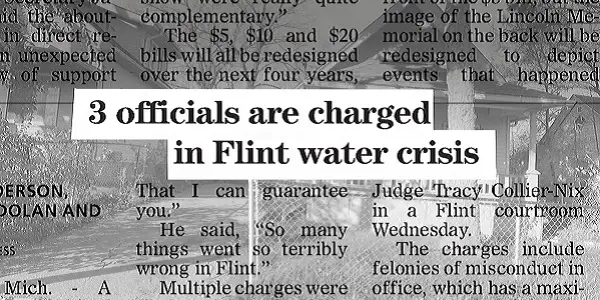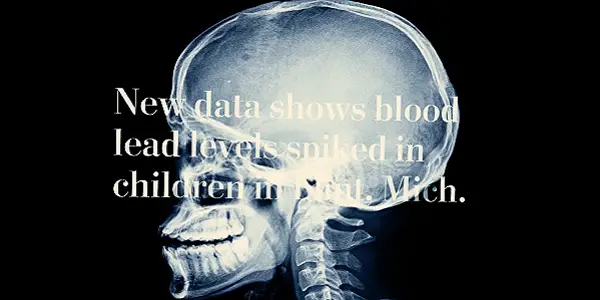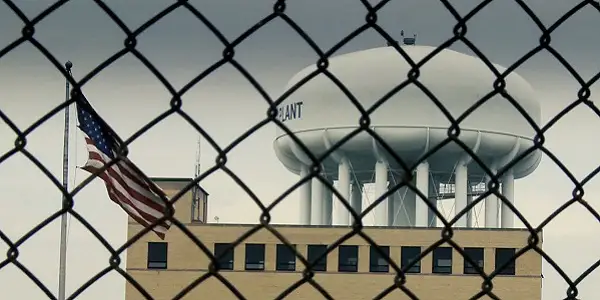FLINT: THE POISONING OF AN AMERICAN CITY: Unraveling An American Crime

Lee Jutton has directed short films starring a killer toaster,…
One of the more popular entries into the pop culture zeitgeist of 2019 was HBO’s miniseries Chernobyl, which dramatized the 1986 Chernobyl nuclear disaster. From the misinformation that increased distrust in the Soviet government to the sickness and death suffered by so many in the aftermath, Chernobyl was a national tragedy of epic proportions. And yet, American audiences don’t have to look across the ocean and back in time to find a similar tragedy that continues to unfold in our own backyard.
A warning cry in the form of a documentary, Flint: The Poisoning of an American City examines how the once-thriving city of Flint, Michigan was poisoned by its own water supply. Directed by David Barnhart, the film is a necessary reminder that the Flint water crisis should remain top of mind for every American. We’ve been taught that such tragedies can never happen here; Flint shows us that when it comes to neglecting its own citizens, our government is capable of crimes like any other.
Once Upon a Time in Flint
In the early-to-mid 20th century, Flint was a boomtown, nicknamed “Vehicle City” thanks to the thriving automotive industry in the area. As people moved to Flint to take jobs at General Motors, which was headquartered there, prosperity followed. Additional businesses, schools, and other local institutions, including the Flint Cultural Center, were established to cater to the growing population. It was, as one of the interviewees in the documentary puts it, “one of the premier cities of the nation” in the years following World War II – a place anyone would love to settle down with a good union job, a white picket fence, and a happy family.

So, what went wrong? First, the American automotive industry fell behind as imported vehicles took an increasingly larger share of the market. GM drastically cut jobs. Deindustrialization led to depopulation as workers left to find new opportunities elsewhere. Poverty and decay took hold.
With the city descending deeper and deeper into a financial crisis, its infrastructure began to crumble. The then-governor of Michigan, Rick Snyder, put an emergency manager in charge of Flint, who decided that one way the city could save money would be to stop purchasing Lake Huron water from Detroit and to instead get its water supply from the nearby Flint River.
As Flint: The Poisoning of an American City shows us, just because a solution is cheap and efficient doesn’t mean it has our best interests at heart. The powers that be skipped applying corrosion inhibitors, which meant lead from the aged pipes leached into the water supply. The result was that, once the water supply was switched to the Flint River in 2014, the entire city became exposed to lead-contaminated drinking water.

Since then, residents of Flint – many of whom appear in this documentary – have reported afflictions that include physical weakness, hair loss, and kidney failure. Children exposed to contaminated water appear to be suffering from developmental delays and other long-term effects. Water bills have skyrocketed despite the water still testing for high levels of lead; bottled water is the only way to ensure safety.
It Can Happen Here, It Can Happen Anywhere
Flint: The Poisoning of an American City looks at both the causes and the effects of the Flint water crisis with an eye that is red with rage. That rage is infectious, and best summed up by one Flint resident who says, “This isn’t supposed to be happening to us in America.” The film traces how the American promise was broken by the U.S. government and others when it came to Flint, with racial and economic segregation ensuring that the city remained a low priority for the state of Michigan even when the crisis was already being recognized. Indeed, an emailed list of Governor Snyder’s list of priorities at the start of 2015 had Flint’s water at a criminally low 36th place. As one Flint community leader tells us, “We are all very priceless, but the system here is telling you you’re not worth anything.”
While the most heartbreaking portions of the film are the interviews with members of the Flint community, the most enraging are the clips from the hearings involving Governor Snyder and other officials, where they are confronted with their own incompetence and can barely shrug in response. When Congressman Elijah Cummings, who recently passed away, rails at those responsible for the poisoning of Flint, his voice cracking with emotion, one is reminded at what we lost when he passed away: a true champion of the people. How many of those are left?

In Flint: The Poisoning of an American City, those remaining champions are found not in the U.S. government, but in science. While it might be the most egregious example, Flint isn’t the only city whose water supply is in violation of federal lead rules – and indeed, as of today Flint still doesn’t have clean water. What happened there could happen in so many more places if we do not listen to scientists and follow their lead to ensure that our water – one of the most necessary elements in our lives – remains safe.
Flint: The Poisoning of an American City: Conclusion
In our current political climate, where it seems like there is a crisis every minute, it has been all too easy for many to forget about what happened and is still happening in Flint. That alone should make this documentary essential viewing.
What do you think? Are you familiar with the Flint water crisis? Share your thoughts in the comments below.
Flint: The Poisoning of an American City is currently available on demand.
https://vimeo.com/222899000
Does content like this matter to you?
Become a Member and support film journalism. Unlock access to all of Film Inquiry`s great articles. Join a community of like-minded readers who are passionate about cinema - get access to our private members Network, give back to independent filmmakers, and more.
Lee Jutton has directed short films starring a killer toaster, a killer Christmas tree, and a not-killer leopard. Her writing has appeared in publications such as Film School Rejects, Bitch: A Feminist Response to Pop Culture, Bitch Flicks, TV Fanatic, and Just Press Play. When not watching, making, or writing about films, she can usually be found on Twitter obsessing over soccer, BTS, and her cat.













